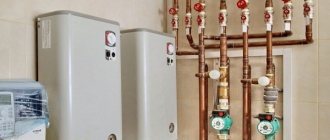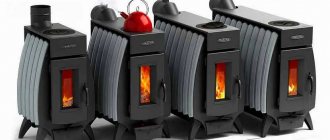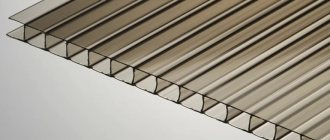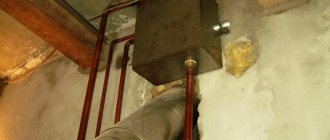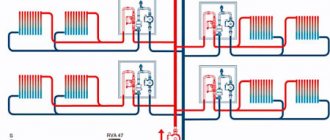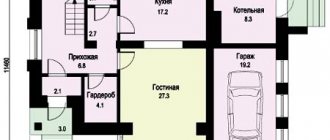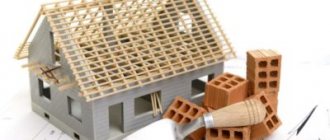Nowadays it is common to combine a kitchen with a living room, a kitchen with a dining room, or even an office. This became possible as soon as people learned to cope with kitchen odors, smoke and steam using kitchen hoods. All dirty air immediately goes into the hood and is discharged outside the home - brilliant! The hoods themselves become an important part of the interior, and sometimes even take on the role of “first violin”.
Types of ventilation
There are only two main types of ventilation: forced and natural, and in some cases combined ventilation is used, which is sometimes classified as a separate category.
As the names indicate, the first type of ventilation uses forced air supply, for which air pumps or fans are used. In the second case, the air flow occurs due to the difference in its temperature and pressure - inside and outside the room. To ensure air exchange, it is enough to position the ventilation holes correctly. Also, some of the air can enter the room through natural openings - for example, cracks under doors.
If there is such a possibility, then it is most profitable to use a combined system - while natural ventilation copes with air exchange, forced ventilation is in standby mode.
Natural ventilation
If the air volume changes three times per hour, then in a standard six-meter (in height) room you can get by with natural air exchange.
For reference! The standards were developed for all boiler houses - industrial and domestic, so the standard was taken to be a room large enough for a private home.
When the ceiling is lowered by every meter, you will have to increase the air circulation by at least 25%. Plus, in any case, you should design the air exchange with some margin.
Scheme of operation of the ventilation system in the boiler room of a private house Source pew.ledikycora.ru.net
The scheme is extremely simple - opposite the boiler, in the door or wall, there is a ventilation inlet (the diameter depends on the power of the boiler), which is located no higher than its working area. The second, the exhaust hole is arranged above the boiler; usually an air duct with a check valve is attached to it (so that the hood only works in one direction) and an “umbrella” on the outside (so that the pipe does not flood).
The distance between the “input” and “exit” of air in the room should be as large as possible to ensure better draft.
Disadvantages of natural ventilation:
- Dependence on weather conditions . It is necessary to protect air ducts from external environmental influences.
- Difficulty in accurately calculating air conditioning. Depending on the direction and strength of the wind, different volumes of air can enter the room.
- It is very difficult to design one ventilation system for several rooms - so that one pipe passes through all the rooms. Mostly, the exit from each room is made directly to the street.
Forced ventilation system or, more simply, an exhaust hood for a boiler in a private house Source m.yukle.mobi
See also: Contacts of companies that specialize in ventilation and air conditioning.
Forced ventilation
Forced air supply is carried out by so-called “mechanical devices”, that is, fans. This type of air exchange arrangement is convenient for two reasons :
- It becomes possible to install climate control equipment , with heaters and filters, which will clean and heat the incoming air;
- It also becomes possible to turn on the system only at the necessary moments , which will save energy by turning it on, for example, only when the boiler is operating.
The disadvantages of forced ventilation are as follows:
- Cost - first of all, such a system will cost more than natural ventilation;
- In some cases, noise – for example, when installing climate control equipment with air conditioning;
- Choosing equipment without proper preparation can be fraught with a safety violation: in particular, for gas boiler houses it is important to have fire-resistant equipment.
The heating system is a rather complex set of equipment, so its selection and adjustment should be carried out by professionals Source stroimdom.com.ua
What you should know
It doesn’t matter for what purpose you are interested in a kitchen hood without an outlet or together with one. The important thing is to imagine how it works. The installed device, no matter how complex and technologically advanced it may seem, must first of all extract exhaust air. Giving space in the room to be filled with new and fresh.
The most common models simply draw in dirty air, like a vacuum cleaner, and carry it out through the ventilation system. More technologically advanced devices first filter it one or several times, after which the processed material is released back into the room.
Such a decision may seem strange to some, since wouldn’t it be easier to simply provide an influx of new oxygen? But in fact, the second option makes it faster, since cleaning is a lightning-fast process.
If you are still thinking about installing a hood in the kitchen without outside help, then do not be lazy and check the serviceability of all ventilation ducts. A faulty duct system reduces towing power, which may not be noticeable.
The hood is on, the motor is running, but no air will flow. Therefore, take the time, perhaps even more than one day and more than one, and clean the ventilation. No matter how good the device used is, it does not affect the accumulation of grease and dirt on the walls of the air duct.
Also pay attention to what kind of windows are installed in your home. If it is plastic, ensuring maximum tightness, then it will be necessary to periodically ventilate the rooms using valves in the hood.
There are two types of hoods:
- Active;
- Passive.
In the first case, we have a fully functioning engine, which requires high power consumption to power it. Such models are more reliable and suck air more intensively than the second samples. They have a regular fan installed, which works like a floor fan, only in reverse, drawing air into the steel hood duct.
The main disadvantage is that over time, dirt and grease quickly accumulate on the blades and the central pin, as a result of which the fan can begin to creak and hum.
What requirements must be met?
After the stage of construction or creation of the boiler room, they move directly to its design, and here again SNiP standards come to the fore. There are quite a lot of them, so we will consider only the most important ones that directly affect cost and design:
- for each boiler , if there are several of them, it is necessary to equip its own ventilation system;
- a gas boiler requires a separate room if it is more powerful than 30 kW, otherwise installation in another room (for example, a kitchen) is allowed, but its area should not be less than 15 m and the ceiling should not be lower than 2.5 m;
- if the boiler room is equipped in a separate extension , then the latter should stand on the foundation;
- it is necessary to provide conditions for convenient cleaning of the hood;
- the vent (ventilation hole) for each kW of power should be 8 cm2 in the case of intake from the street, or 30 cm2 if the ventilation takes air from other rooms;
- the hood for a boiler in a private house must be located on top ;
It is advisable to supplement the ventilation system with an extractor hood for a gas boiler in a private house Source tigerrupakix.tumblr.com
Air duct laying
The duct pipe can be made of corrugated plastic, steel or aluminum. These materials have different characteristics. The most common is aluminum. It is quite durable and not as expensive as steel.
The air duct is placed on the protruding socket of the exhaust unit and tightened with a clamp. Similarly, the corrugation is attached to a pipe with a valve system. The corrugation is secured to the wall in several places with a clamp and dowels and covered with a wall cabinet or casing.
Important! Before tightening the clamp in the right place, the connection is treated with silicone sealant.
If there is no casing included with the hood to mask the air duct and there is no wall cabinet provided, use a special rectangular plastic pipe or install a plasterboard box. The main condition: the box must withstand the load of its own weight and the weight of the air duct.
Algorithm for installing an air duct:
- Mark the position of all structural elements up to the attachment points.
- Holes are drilled in the wall and hangers are attached.
- Install the air duct elements.
- Seal joints.
- The pipe is attached to the wall and connected to the system.
A practical solution is to wrap the air duct with a layer of soundproofing material before hiding it behind the walls of the duct.
Chimney of a gas boiler for a private house
You should know that liquefied gas boiler rooms cannot be located in the basement of buildings or basements. This requirement is determined by common sense: in the event of a leak, fuel of this type can accumulate in the lower layers of air and “drain” down. Otherwise, such a boiler room, according to the standards, can be located in a separate building or an extension to the house, or in the attic. But, at the same time, ventilation in a private house for a gas boiler imposes a number of mandatory requirements :
- Ventilation in the boiler room of a private house in this case should use two horizontal channels , with one for the ventilation chimney located at its level, and the second about a quarter of a meter lower, used for cleaning;
- The boiler must be at least 0.1 m ;
- The chimney should not make more than three bends.
Installation of the supply valve
The supply valve is needed to replenish the air reserves that are removed during operation of the exhaust system. The valve can be autonomous (wall) or additional (window).
During installation:
- Disassemble the valve.
- Mark the outline on the wall.
- Drill a hole and insert the sleeve.
- Place the insulated valve tube into the hole.
- The body is attached to the dowels.
Next, install the filters and check the operation of the damper.
How is ventilation calculated?
When calculating the ventilation system, it is worth considering that small-power gas boilers (up to 30 kW), according to the law, are calculated using a slightly different formula, because a number of requirements according to SNiP are different.
So, for natural ventilation of a room measuring 3 by 5 m, with a ceiling height of 3 m, you must first calculate the volume: in this case it will be 45 m3 (we multiply all the parameters). Now the air exchange: 6 (the height that should be) – 3 m (our ceiling) should be multiplied by the “penalty” coefficient of 0.25 and add 3 meters. The result will be 3.75. Now you need to understand what the value of air circulation is: for this, the air exchange rate is multiplied by the square footage of the room, in the example the result is 168.75 m3 - this is the value that you then need to look at in a special table to determine the diameter of the air duct. In our case it will be 225 mm.
Heating system with gas boiler Source radio.enjob.ru
In the case of a gas boiler, the 0.01 m2/10 kW scheme is used for the supply lines - that is, if the boiler has a power of 30 kW, then the ventilation of the boiler room should provide an air flow of about 0.03 m3/sec, plus, it is advisable to include a 30% reserve. The hood, according to SNiP, must have a cross-section of at least 130 mm. If the supply ventilation hole does not provide proper air exchange, then forced supply ventilation is installed.
Expert advice
Tips from experts on equipment selection and installation:
- If you choose a strong and durable hood, take a closer look at models made of stainless steel and aluminum.
- If you choose a fan with high power and too much air flow, this may lead to blockage of the air duct. This will cause all the smell and smoke to spread to other rooms.
- Ventilation ducts and air ducts should be cleaned periodically. Please consider this before choosing.
- If the kitchen is more than 15 square meters, two ventilation ducts are installed. One will serve to fill with fresh air, and the second will serve for exhaust.
- It is important to consider that the decorative grille and valve sometimes reduce the speed of air movement by 10 times. In this regard, do not opt for a device with minimal power.
- When choosing a hood, take into account the volume of air that needs to be purified within an hour. We take the volume of the kitchen, multiplying the area by the height, multiplying by the air exchange rate (12) and multiplying by 1.3 (minimum reserve coefficient). This way you will get the performance of the hood.
- When determining the dimensions of the hood, take into account that the area of the air intake should correspond to the area of the working surface of the stove, or better yet, exceed it.
- How to take into account a comfortable noise level? 20 decibels is like the rustling of pages, 25-35 is about like a loud whisper, 50 dB is the noise level like during a normal conversation, 89-90 is like the noise of a passing motorcycle or a hair dryer when drying, 110 is like how it works drill or hammer drill, 130 dB is already exceeding the pain limit.
- When choosing a hood, the question may arise: do you need lighting? They are automatic, touch-activated or with a button. Experts believe that the presence or absence of lighting does not in any way affect the main tasks of the hood, so when choosing, be guided solely by your budget and your own taste. Focus on how the hood design will fit with the interior design.
Selection and installation of equipment
The selection of equipment will depend primarily on the following factors :
- area ;
- Permissible distance to combustible devices;
- Type of room (separate room, free-standing room or existing one - for example, a kitchen or attic);
- Budget (for example, monoblock ventilation is significantly quieter than other types, but it will cost more)
The boilers themselves are:
- Gas;
- Solid fuel;
- Pellet (pellet-based, essentially solid fuel boilers);
- Diesel;
- Electrical;
- Combined (using several methods).
Combination boilers are an excellent option in a home where there are interruptions in electricity or gas supply Source brjansk.buyreklama.com
Currently, gas boilers are most often used in private homes, and we are talking about low-power boilers. This is due to the relatively low price of gas in gasified areas, and the convenience of using this heating method (the combustion temperature is lower, which allows the use of cheaper materials in production). To install it you will need permits. In addition, the boiler can be installed simultaneously with water heating (with a boiler) only for rooms up to 200 m2.
Creating a box to mask air ducts
There are two materials for making the box - plastic and plasterboard.
The plastic box consists of ready-made elements. Install it under the ceiling or above wall cabinets. The box is durable and weighs little, so you can install it without outside help.
Attention! Before masking the duct corrugation, the system is checked for leaks.
A plasterboard box is a complex structure that requires skills in working with this material. A frame is made from a metal profile, sheets of plasterboard are sewn onto it, then the structure is covered with putty and decorative finishing is performed.
It is better to install at least two inspection hatches in a plasterboard box. This will make it easier to access the air duct if necessary.
How to choose material for the hood
The hood can be constructed from various materials. Below is a list of the main ones.
- Brick – used for exhaust hood in solid fuel boiler houses. It is quite difficult to clean, but it lasts a long time in the case of solid fuel boilers. For gas and other boilers, this type will not be a good choice, because they have a lower temperature - condensation forms in the pipe, and the surface of the brick quickly collapses;
Brick air duct Source en.yenni.biz
- Ceramics can be different; for solid fuel boilers, ceramics are used that can withstand temperatures of more than 650°C. It is also necessary to ensure that soot does not ignite in the chimney. For liquid fuel (and gas) you can use a ceramic hood using a lower temperature range, but with condensate removal. Insulation of the pipe should be provided (most often it is insulated with mineral wool);
- Steel is a good choice for solid fuel heaters, and if ventilation is used in a boiler room with a gas boiler. In the case of a higher temperature (solid fuel), you should simply choose a thicker pipe, up to 1 mm, in others - 0.6 mm. The steel must be heat resistant. The only negative is that such pipes cannot be called cheap, and their service life is shorter than, for example, brick.
The choice of a specific material depends on the combination of corrosion resistance parameters and resistance to soot (its accumulation). In addition, the hood is selected according to the draft pressure (forced ventilation implies excess pressure), according to the degree of condensation formation from the fuel, and according to the smoke temperature. It is worth knowing that the hood can be reconstructed - for example, the hood for a gas boiler in a private house, if there is already a brick pipe, is organized by inserting a steel pipe into a brick chimney, subject to other conditions.

